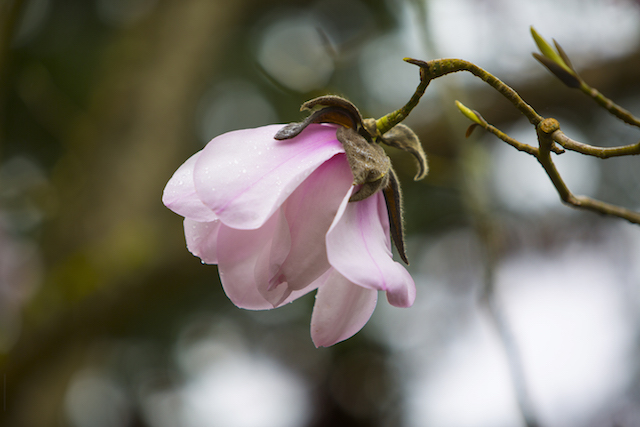Waiting for Magnolias
Outside the Trust Cottage in the Dunn Gardens where I live, is a mature magnolia, Sargent’s Magnolia. It’s a bit easier to say than the Latin (Magnolia sargentia var robusta). Its muscular, twisting branches, poking about 35 feet up and out into the winter air, are bare now. I keep staring at it out of the window, hoping the pale pink and floppy flowers will soon appear to comfort me out of the dark days of the cold season. If experience is a guide they could show as early as February. Or they could be—horrors—as late as April.
The tree was planted in the 1960s, but when there is morning mist wrapped in and around the branches it appears as old as time. This is not surprising. Magnolias were around when the dinosaurs reigned on earth, and before bees and flying pollinators had evolved. Pollination is left to sap beetles who are attracted to the fragrant, sugary secretions of the flowers.
Sargent’s Magnolia has extended family living in the grounds of the garden. The M. kobus is one such ‘cousin.’ It was planted in the 1920s and in its maturity is, like Sargent’s Magnolia, an early spring bloomer. The tree has been carefully pruned and propped up over the years. When it is covered in thousands of white, star-shaped blossoms it is possible to stand in the middle of it on the gravel path and feel transported to a lovely secret world; a warmer and more forgiving one than that of the current moment.
One of the few magnolias shy about showing off its flowers is the M. acuminata. The garden has a specimen that towers over the great lawn, justly proud of its heritage status. (It was one of the original plantings in the garden.) The common name, Pickle or Cumber Magnolia is derived from the unripe fruit which is green and shaped like a … you know what. The flowers are small and yellowish and, as noted, retiring, so they are hard to spot in spring. Very ‘unmagnolia’ like. When the blooms cannot be located we assure visitors the tree earns our affection for the summer shade the pointed leaves deliver.
Perhaps the most well known of all magnolias, and the one that comes to the layman’s mind, is the M. grandiflora, often referred to as the southern magnolia. Personally, they remind me of elephants or whales. Like those creatures they have both scale and grace. It is not unusual to find mature specimens at 90 feet tall with leaves that can reach eight inches. The white flowers are spectacular, not to mention fragrant and can span 12 inches in diameter. They are, perhaps, the most magnolia of magnolias. Our variant cultivar, M. grandiflora ‘D. D. Blanchard’ will not likely grow past 75 feet but is considered to be cold hardy and blooms in late spring.
Happily, Dunn Gardens has many more magnolias than those described and many of them are listed below. They bloom from early spring through June, adding their touch of magic to the landscape. The garden will open for the Wanders,* initiated in 2017 when the various magnolias are at their height so visitors can enjoy their splendor.
But, I have to say, right now, in the middle of the shivery season, I just want the Sargent’s Magnolia to start showing off her flowers on the bare branches. Then, I will be assured that there are more magnolia delights ahead. That prospect will warm me up no end.
*Wanders are a membership benefit. Members may bring up to three guests to wander the grounds of the garden between the hours of 10:00 am and 1:00pm on Tuesday and Friday of each week, April through October. In addition, when there is something of particular interest, as in a magnificent magnolia show, the garden will let you know so you can enjoy it also.
Some Varieties of Magnolia at Dunn Gardens
1. M. sieboldii
2. M. kobus
3. M. acuminata
4. M. ‘Yellow Butterflies’
5. M. zenii
6. M. x weiseneri
7. M. sargentiana var. robusta
8. M. sargentiana var. robusta ‘Blood Moon’
9. M. ‘Felix Jury’
10. M. ‘Genie’
11. M. ’Sunset Swirl’
12. M. ‘Serene’
13. M. x ‘Vulcan’
14. M. ‘Phelan Bright’
15. M. x thompsoniana
16. M. x soulangeana ‘Alba’, ‘Alba Superba’, or ‘Lennei Superba’
17. M. campbellii ‘Lanarth’
18. M. sprengeri ‘Burncoose’
19. M. sprengeri ‘Eric Savill’
20. M. ‘J. C. Williams’
21. M. ‘Brixton Belle’
Three to four of the magnolias are early bloomers, liable to frost damage, as the existing M. sargentiana is, but with our climate in flux we seem to be moving more solidly into zone 8, which should allow for success most years.

